Sobhan Goudarzi
Denoising Plane Wave Ultrasound Images Using Diffusion Probabilistic Models
Aug 20, 2024



Abstract:Ultrasound plane wave imaging is a cutting-edge technique that enables high frame-rate imaging. However, one challenge associated with high frame-rate ultrasound imaging is the high noise associated with them, hindering their wider adoption. Therefore, the development of a denoising method becomes imperative to augment the quality of plane wave images. Drawing inspiration from Denoising Diffusion Probabilistic Models (DDPMs), our proposed solution aims to enhance plane wave image quality. Specifically, the method considers the distinction between low-angle and high-angle compounding plane waves as noise and effectively eliminates it by adapting a DDPM to beamformed radiofrequency (RF) data. The method underwent training using only 400 simulated images. In addition, our approach employs natural image segmentation masks as intensity maps for the generated images, resulting in accurate denoising for various anatomy shapes. The proposed method was assessed across simulation, phantom, and in vivo images. The results of the evaluations indicate that our approach not only enhances image quality on simulated data but also demonstrates effectiveness on phantom and in vivo data in terms of image quality. Comparative analysis with other methods underscores the superiority of our proposed method across various evaluation metrics. The source code and trained model will be released along with the dataset at: http://code.sonography.ai
Phase Aberration Correction: A Deep Learning-Based Aberration to Aberration Approach
Aug 22, 2023



Abstract:One of the primary sources of suboptimal image quality in ultrasound imaging is phase aberration. It is caused by spatial changes in sound speed over a heterogeneous medium, which disturbs the transmitted waves and prevents coherent summation of echo signals. Obtaining non-aberrated ground truths in real-world scenarios can be extremely challenging, if not impossible. This challenge hinders training of deep learning-based techniques' performance due to the presence of domain shift between simulated and experimental data. Here, for the first time, we propose a deep learning-based method that does not require ground truth to correct the phase aberration problem, and as such, can be directly trained on real data. We train a network wherein both the input and target output are randomly aberrated radio frequency (RF) data. Moreover, we demonstrate that a conventional loss function such as mean square error is inadequate for training such a network to achieve optimal performance. Instead, we propose an adaptive mixed loss function that employs both B-mode and RF data, resulting in more efficient convergence and enhanced performance. Finally, we publicly release our dataset, including 161,701 single plane-wave images (RF data). This dataset serves to mitigate the data scarcity problem in the development of deep learning-based techniques for phase aberration correction.
Deep Ultrasound Denoising Using Diffusion Probabilistic Models
Jun 12, 2023
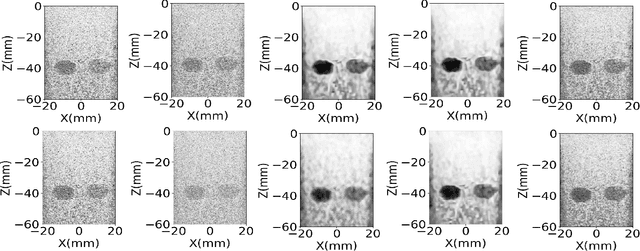


Abstract:Ultrasound images are widespread in medical diagnosis for musculoskeletal, cardiac, and obstetrical imaging due to the efficiency and non-invasiveness of the acquisition methodology. However, the acquired images are degraded by acoustic (e.g. reverberation and clutter) and electronic sources of noise. To improve the Peak Signal to Noise Ratio (PSNR) of the images, previous denoising methods often remove the speckles, which could be informative for radiologists and also for quantitative ultrasound. Herein, a method based on the recent Denoising Diffusion Probabilistic Models (DDPM) is proposed. It iteratively enhances the image quality by eliminating the noise while preserving the speckle texture. It is worth noting that the proposed method is trained in a completely unsupervised manner, and no annotated data is required. The experimental blind test results show that our method outperforms the previous nonlocal means denoising methods in terms of PSNR and Generalized Contrast to Noise Ratio (GCNR) while preserving speckles.
Inverse Problem of Ultrasound Beamforming with Denoising-Based Regularized Solutions
Jun 16, 2022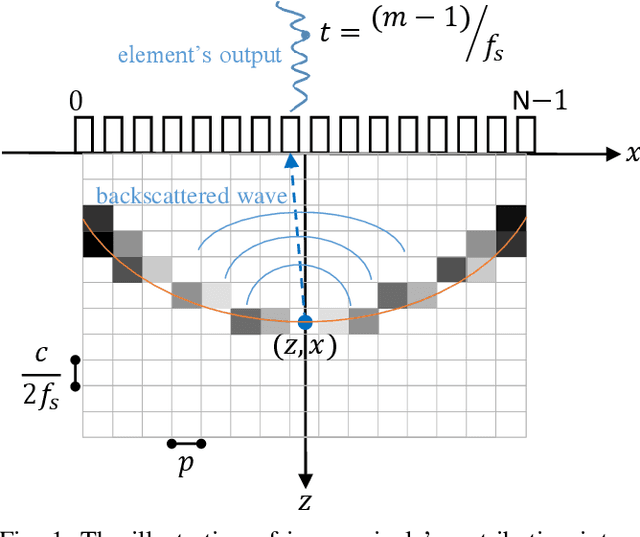
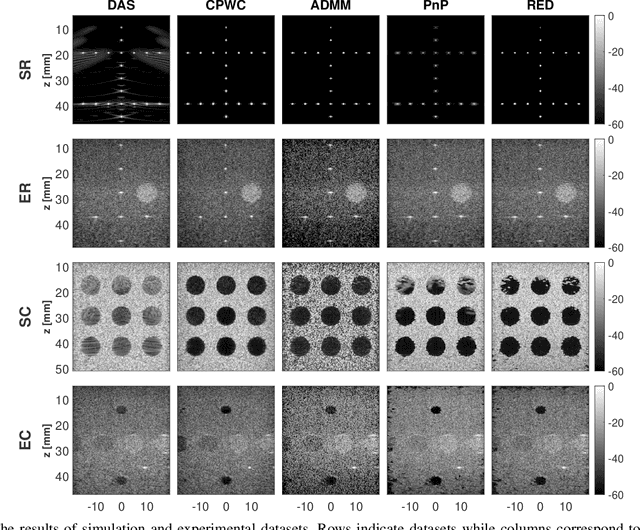
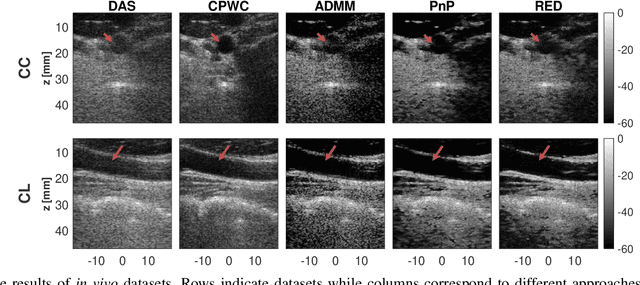

Abstract:During the past few years, inverse problem formulations of ultrasound beamforming have attracted a growing interest. They usually pose beamforming as a minimization problem of a fidelity term resulting from the measurement model plus a regularization term that enforces a certain class on the resulting image. Herein, we take advantages of alternating direction method of multipliers to propose a flexible framework in which each term is optimized separately. Furthermore, the proposed beamforming formulation is extended to replace the regularization term by a denoising algorithm, based on the recent approaches called plug-and-play (PnP) and regularization by denoising (RED). Such regularizations are shown in this work to better preserve speckle texture, an important feature in ultrasound imaging, than sparsity-based approaches previously proposed in the literature. The efficiency of proposed methods is evaluated on simulations, real phantoms, and \textit{in vivo} data available from a plane-wave imaging challenge in medical ultrasound. Furthermore, a comprehensive comparison with existing ultrasound beamforming methods is also provided. These results show that the RED algorithm gives the best image quality in terms of contrast index while preserving the speckle statistics.
Deep Ultrasound Denoising Without Clean Data
Jan 07, 2022



Abstract:On one hand, the transmitted ultrasound beam gets attenuated as propagates through the tissue. On the other hand, the received Radio-Frequency (RF) data contains an additive Gaussian noise which is brought about by the acquisition card and the sensor noise. These two factors lead to a decreasing Signal to Noise Ratio (SNR) in the RF data with depth, effectively rendering deep regions of B-Mode images highly unreliable. There are three common approaches to mitigate this problem. First, increasing the power of transmitted beam which is limited by safety threshold. Averaging consecutive frames is the second option which not only reduces the framerate but also is not applicable for moving targets. And third, reducing the transmission frequency, which deteriorates spatial resolution. Many deep denoising techniques have been developed, but they often require clean data for training the model, which is usually only available in simulated images. Herein, a deep noise reduction approach is proposed which does not need clean training target. The model is constructed between noisy input-output pairs, and the training process interestingly converges to the clean image that is the average of noisy pairs. Experimental results on real phantom as well as ex vivo data confirm the efficacy of the proposed method for noise cancellation.
A Unifying Approach to Ultrasound Beamforming and Deconvolution Using ADMM
Dec 28, 2021



Abstract:Beamforming is an essential step in the ultrasound image formation pipeline and has attracted growing interest recently. An important goal of beamforming is to improve the quality of the Point Spread Function (PSF), which is far from an ideal Dirac delta function in ultrasound imaging. Therefore, deconvolution as a well-known post-processing method is also used for mitigating the adverse effects of PSF. Unfortunately, these two steps have only been used separately in a sequential approach. Herein, a novel framework for combining both methods in ultrasound image reconstruction is introduced. More specifically, the proposed formulation is a regularized inverse problem including two linear models for beamforming and deconvolution plus additional sparsity constraint. We take benefits of the Alternating Direction Method of Multipliers (ADMM) algorithm to find the solution of the joint optimization problem. The performance evaluation is presented on a set of publicly available simulations, real phantoms, and in vivo data from the Plane-wave Imaging Challenge in Medical UltraSound (PICMUS). Furthermore, the superiority of the proposed approach in comparison with the sequential approach as well as each of other beamforming and deconvolution approaches alone are also shown. Results demonstrate that our approach combines the advantages of both methods and offers ultrasound images with high resolution and contrast.
Plane-Wave Ultrasound Beamforming: A Deep Learning Approach
Sep 27, 2021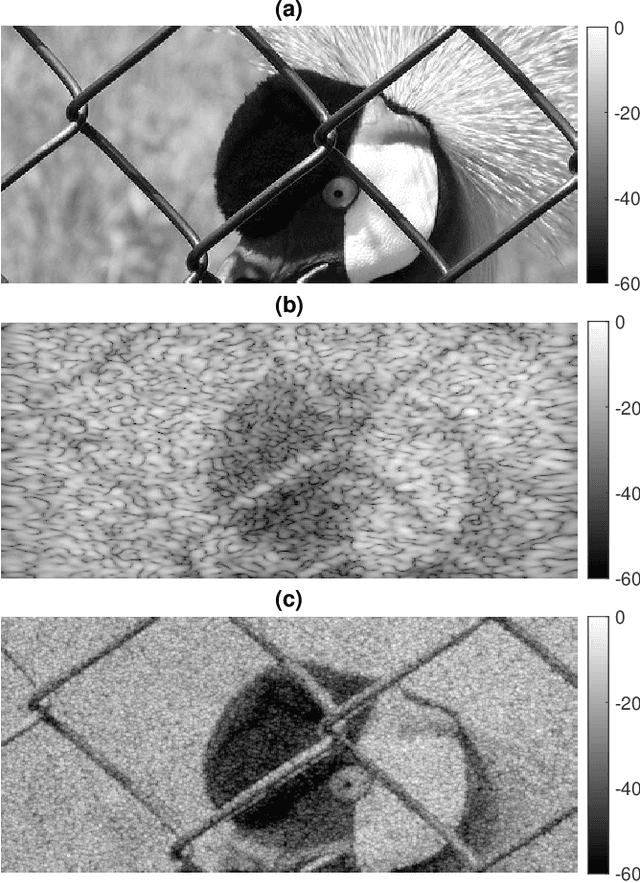
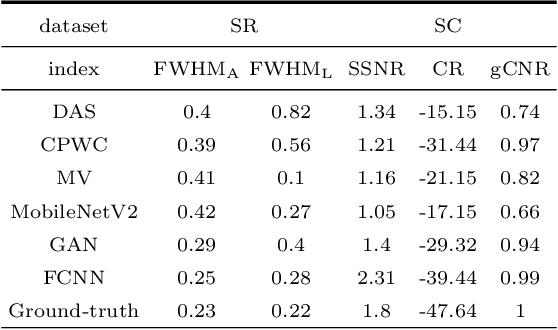


Abstract:Medical ultrasound provides images which are the spatial map of the tissue echogenicity. Unfortunately, an ultrasound image is a low-quality version of the expected Tissue Reflectivity Function (TRF) mainly due to the non-ideal Point Spread Function (PSF) of the imaging system. This paper presents a novel beamforming approach based on deep learning to get closer to the ideal PSF in Plane-Wave Imaging (PWI). The proposed approach is designed to reconstruct the desired TRF from echo traces acquired by transducer elements using only a single plane-wave transmission. In this approach, first, an ideal model for the TRF is introduced by setting the imaging PSF as a sharp Gaussian function. Then, a mapping function between the pre-beamformed Radio-Frequency (RF) channel data and the proposed TRF is constructed using deep learning. Network architecture contains multi-resolution decomposition and reconstruction using wavelet transform for effective recovery of high-frequency content of the desired TRF. Inspired by curriculum learning, we exploit step by step training from coarse (mean square error) to fine ($\ell_{0.2}$) loss functions. The proposed method is trained on a large number of simulation ultrasound data with the ground-truth echogenicity map extracted from real photographic images. The performance of the trained network is evaluated on the publicly available simulation and \textit{in vivo} test data without any further fine-tuning. Simulation test results confirm that the proposed method reconstructs images with a high quality in terms of resolution and contrast, which are also visually similar to the proposed ground-truth image. Furthermore, \textit{in vivo} results show that the trained mapping function preserves its performance in the new domain. Therefore, the proposed approach maintains high resolution, contrast, and framerate simultaneously.
 Add to Chrome
Add to Chrome Add to Firefox
Add to Firefox Add to Edge
Add to Edge